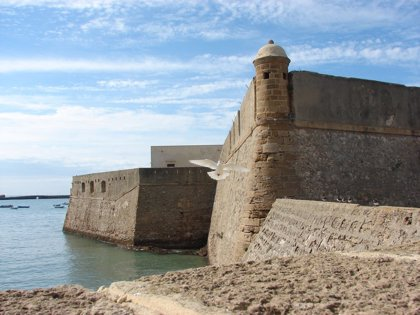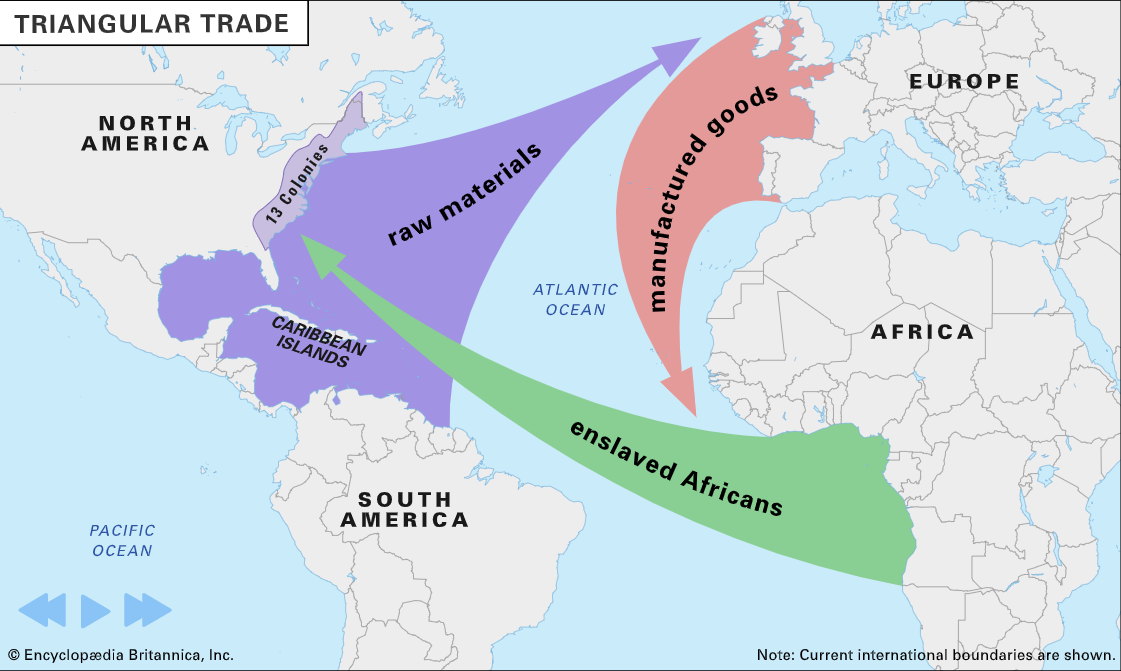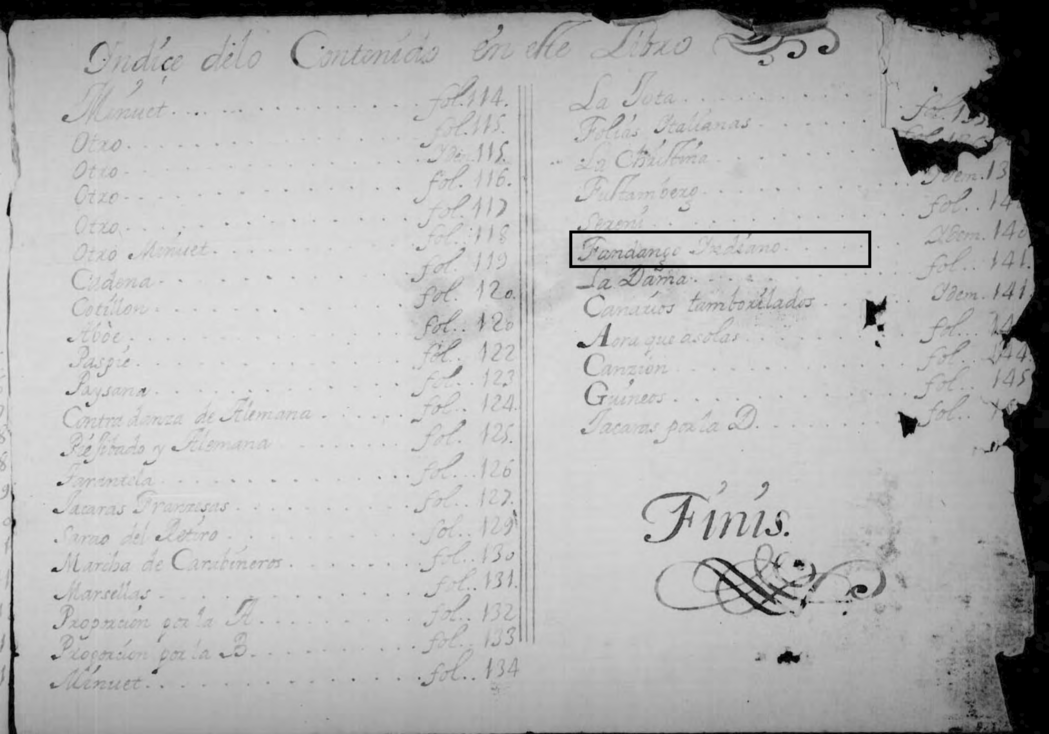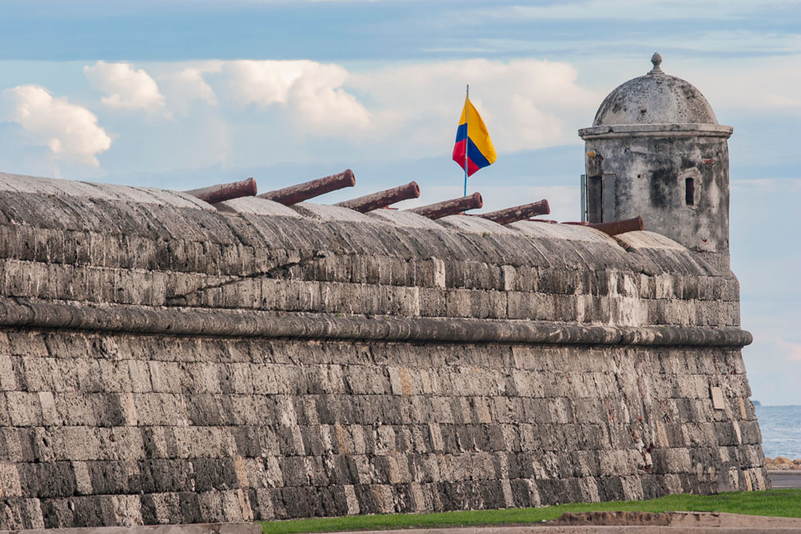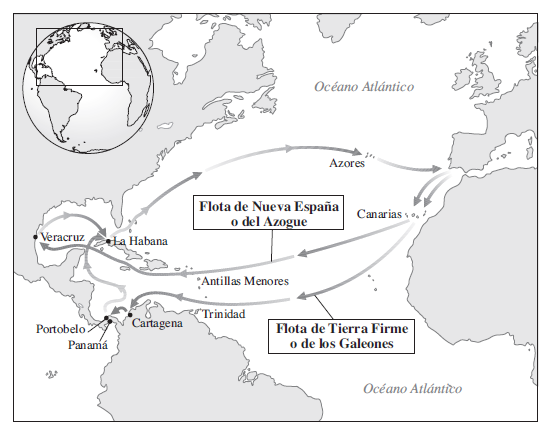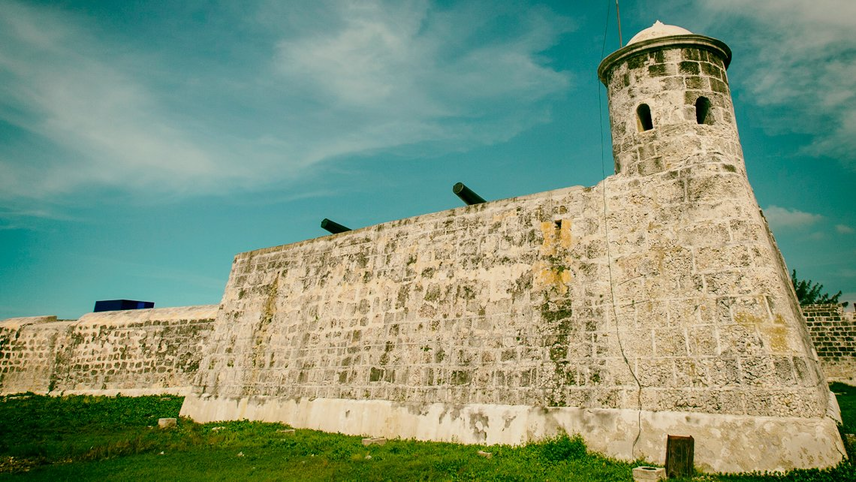Transatlantic triangular Savetrade. Click on the image to play video. (Source: T. Editors of Encyclopaedia. "Transatlantic Slave Trade Key Facts." Encyclopedia Britannica, November 23, 2020)
The Atlantic Ocean of colonial times was a space of incredible dynamism. García de León describes it as the ocean of the first globalization (García de León 2002, 209), characterized by the intense trade which made possible the major social and economic shifts of modern-age Europe.
The extensive exploitation of the American treasure started financing the European Renaissance by the beginning of the XVI century. Later, the flow of colonial goods such as sugar, and the involvement of German and Italian bankers in the enterprise of the conquest would impulse the birth of modern capitalism (Galeano 2014, 199). This circulation, reflected in the Atlantic Ocean, was reconfiguring the world.
In political terms, the articulation of vast parts of America and Oceania under the reign of Charles V (1500-1588) ensured the hegemony of the Spanish Empire. The Pacific and Atlantic oceans were thus united in an imperial project of global aspirations, however, the transatlantic slave trade would bring France, Netherlands, and Britain into play. The Atlantic triangular slave trade, which operated between West Africa, Europe, and the Caribbean, produced a chain of exchange of raw materials, enslaved working force, and manufactured goods in which colonial potencies would dispute the upper hand. This Atlantic economy would become the financial motor of the European societies until the XIX century, making the Caribbean Sea a focus of the African diaspora, determining its cultural landscape1.
Such is the picture of that neuralgic Atlantic Ocean of colonial times. It was the stage in which the reconfiguration of the modern world was reflected, and where the fandango would sprout among a melange of enslaved Africans, Spanish sailors, decimated Amerindians, and a growing "criollo" or mixed-raced population that would make up the emerging Hispanic societies.
The first Spanish dictionary, published at the beginning of the XVIII century, defines the fandango as a “Dance introduced by those who have been in the Kingdoms of the Indies, which is done to the sound of a very happy and festive tolling”2. This source is a testimony of the growing popularity of a vernacular dance perceived as exotic and improper, which was quickly penetrating all societies of the Hispanic world. It was a percussive tune strummed with the guitar, to which couples would dance with stomping feet.
Born from the cultural exchange with the Spanish colonies in the Americas and the transatlantic slave trade the fandango entered the Iberian peninsula with the repertoire of the five-course guitar. The first examples appear in the "Libro de diferentes cifras de guitara escojidas de los mejores autores" from 1705, an anonymous manuscript laid in the national library of Spain, compiling all sorts of popular dance music. Among typical court dances like the Chaconne and the Pavanne, three fandangos written in simple cipher are to be found - one of those labeled as “Fandango from the Indies”.
It is no coincidence to see the fandango arriving with the guitar, coming from the lowest rungs of Hispanic society. Since the XVI century, the guitar was the instrument for popular entertainment per excellency, a natural enemy of the Lute, the counterpoint, and the good manners. The strumming way of playing it, commonly labeled “a la española” or "in the Spanish way”, was a very practical, easy musical support for almost every sort of dance and song (García de León 2002, 138). In the context of the musical transculturation between Europe, Africa, and the New World during colonial times, the guitar played a key role. The five-course baroque guitar or its predecessor, the vihuela, can be imagined as a sort of "indispensable stowaway" traveling back and forth through the Caribbean Sea and the Atlantic Ocean, bringing within its strings the true American treasure: a body of dances that would strongly influence musical life in Europe.
The fandango wasn't the first mixed-race intruder in the European dance repertoire in any way. His ancient cognate, the ostinato-Sarabande, counts among the first and most controversial “musical imports”. It was mentioned for the first time in sources from Central America already by the middle of the XVI century and arrived in the Spanish motherland around 1580 (Walsdorf 2015). The scandal caused by its obscene character is registered in religious claims and petitions to the Spanish Inquisition, like the famous Treatise by Padre Juan de Mariana "Tratado Sobre los Juegos Publicos" from 1606 (Galeano 2014, 223). The inevitable interaction with the Atlantic African diaspora printed bigger freedom in the new dance movements. The war of the Spanish Inquisition against the explicit sexual gesture and text of the sarabande is widely documented, however, despite being banned from the Hispanic monarchy, the sarabande was popularized in the rest of Europe, becoming one of the principal dances of the French courts and eventually entering the dance canon of the baroque suite.
During the XVI and XVII centuries, other "piquant imports" like the Passacalle, the Chaconne, the Folia, the Canarie, or the Jácara, matured in “international waters”. They were all born into the popular entertainment of the Hispanic society, most notably, the street theaters or “Corrales de Comedia”, in which dances were an essential part, according to Spanish guitarist Luis de Briceño in 1626 (García de León 2002, 138). This body of vernacular dances consisted of endlessly reiterated chordal ostinatos in ternary meter. The chordal patterns were not rigid, on the contrary, the ancient, undocumented dances seemed to have been fluid entities. Especially the triad composed of the Passacaglia, Chaconne, and the ancient ostinato-Sarabande is difficult to delimit. Before they started to be notated in European collections, the progressions might have been changed indistinctively, seeming to be interchangeable (Weinman 2020, 85).
The fandango developed out of this dance family probably by the end of the XVII century. It was originally linked to the communal celebrations of the lower cast. Fandango is the music of the popular celebrations known under the same name, observed and documented by travelers of the XVIII century (García de León 2002, 139). It was usually a gathering with dance and song, where improvised verses would be accompanied by a string ensemble. These celebrations became an important way of expression for the emerging mixed-race groups and could be considered as one of the alternative musical realities to the one written down in musical sources of colonial archives. In the fandango celebrations, different groups of colonial life across the Spanish Empire would resist and affirm their cultural identity, particularly Afro-Hispanic groups of the Caribbean, but also Moorish and Gypsy (Roma) groups of Southern Spain. In the coastal regions of the Caribbean and southern Spain, the maritime routes would favor an immediate exchange. The network of the main harbors of the "Ruta de Indias" (the trade route of the west indies) created a common cultural landscape across transatlantic regions, due to the constant commercial interaction. Through the Ruta de Indias, the communal celebration of the Fandango consolidated itself as a part of Hispanic popular culture, together with its corresponding dance, music, poetry, and cultural expressions
A voyage of a Spanish fleet started in the city of Sevilla (from 1680, Cadiz) where the administrative preparations often took several months. The procedures were settled at the offices of the "Casa de Contratación" which had complete control over the trade affairs and exploration of the American colonies. After sailing from the ports of the Guadalquivir River, and later from Cadiz´ Bay, the fleet would make an intermediate stop at the Canary Islands before starting the transatlantic crossing to the Caribbean ports. Veracruz, in Mexico (New Spain), was the main arrival point, but other ports like Portobello (Panama) and Cartagena (Colombia) played a key role in this economic network. On the way back, the fleets would gather in the ports of La Havana, before heading back. Whoever has been in south Spanish and Caribbean ports, can give an account of the similarities of their ancient architecture, their food, and even their Spanish accent. The view of the coastal military defense walls makes the coasts of Cadiz, La Habana, and Cartagena indistinguishable from each other.
Behind this common landscape of docks and ships, we must imagine a vivid human landscape composed of merchants and sailors, but also a very heterogeneous mixture of members of the lower casts of Hispanic society. The human groups surrounding these Atlantic enclaves were akin to maritime trade life, defined by the dangers of the ocean and the promises of social mobility. Adventurers, smugglers, slaves, and outcasts gathered in the ports, where the long waiting periods made entertainment indispensable. These licentious environments nurtured the spirit of the fandango, and from the ports of Cadiz, Sevilla, Veracruz, and La Havana, the dance craze quickly spread into the rest of the Spanish Empire.
Emanating from the streets of the metropoles, the fandango started permeating the Spanish courts, propagating in elite concert halls and salons. The social and cultural shifts of the Enlightenment brought with them the elevation and representation of the popular. As an emblem of majismo, an aristocratic fashion for imitating the underclass, the fandango was embraced by the Spaniards, resulting in a historical example of what we call nowadays "cultural appropriation". Turned into a fashion fight, the "fandango-trend" was raised in Spain in resistance to the "menuet-trend" of the French. It is thanks to this court musical fashion that we have been able to preserve the "shadows" of the popular fandangos of the XVIII century, as street music started to be imitated in aristocratic settings, notated and recorded in cifras of court musicians, dance treatises, libretti of ballets, operas, and tonadillas.
Over the course of the XIX century, with the emergence of the nation-states and the advent of nationalism, the Spanish fandango fashion came to represent the Spanish ethos inside of Europe:
the narrative of Spain as represented by the reviled conquistadores, Torquemada’s Inquisition, and Dominican missionaries (the “dogs of God”), was replaced with the image of Spain as a land of festive bandits and swarthy, gleaming-eyed Gypsies" (Meyra & Pizà 2016, XV)
In an ironic turn of history, this "dance from the Indies" ended up becoming a sign of identity for the emerging Spanish nation.
Something similar happened across the ocean. After the emancipatory processes that would lead to the independence of the American colonies, American fandangos would also become instruments of identitarian representation for the newborn republics. In the Caribbean basin, from the second half of the XIX- until the beginning of the XX century, there was also "an emphasis on nationalistic and regionalist tendencies that synthesized nineteenth-century customs and manners with a certain naturalism coming from Europe and the United States—thus strengthening local fragmentation" (Pérez Monfort 2016, 317). Consequently, Caribbean fandangos settled down in their own local configurations and were brought in association with particular mixed-race stereotypes. Expressions such as “jíbaro,” “jarocho,” “guajiro,” or “llanero”, are often used both as a stereotype to characterize the population and traditional way of living of each specific region, and as a name for their correspondent fandangos in Puerto Rico, Mexico, Cuba, and Venezuela respectively.
This is how, both in the Iberian peninsula and in the Americas, many fandango-related traditions remained alive in popular culture until our days. Some of them are still linked to their function as festive music for their particular regional expressive culture, and some still retain the ritual character of the ancient Fandango-Gatherings, which was so important to resist colonial oppression. The next chapter depens into the subject of the Fandango as a ritual.
"Libro de Diferentes Cifras", Index. Click on the image to go to the digital version of this manuscript by the National Library of Spain
From left to right: the defence-walls from the ports of Cadiz, Cartagena and La Habana. (Sources: Europapress.es, soundwalkrs.com, onlinetours.es)
The Fandango from Codex Saldivar IV by Santiago de Murcia counts among the first sources as well. (Source: Imslp)
